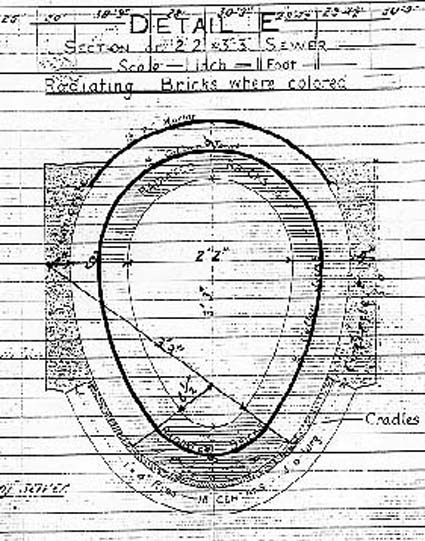Work continued last week on the alley behind the El Moore. Following the removal of the concrete alley surface, deep holes were dug 15 feet down to expose the sewer line. This allows us to create a new sewer connection for the El Moore building. It also allowed us to open a section of the line so that a robotic camera could be run down the sewer to gauge the condition of the line in case repairs needed to be made.
Exposing the sewer line gave us yet another fascinating glimpse of local history — this time, the history of the infrastructure buried underground. In the city of Detroit alone, there are nearly 3500 miles of sewer lines, enough to stretch from Detroit to the North Pole (with 200 miles left over for Santa’s village). The section of city that includes the El Moore was plotted as a neighborhood in the mid 1800s and as a result, the sewer lines that were installed at that time (and that continue to function to this day!) are made of brick.
Mostly all of the public sewers built in Detroit between 1836 and 1910 were constructed of brick and nearly 400 miles of brick sewer  are still in service in the city today. The pipe was built down in a trench, brick by brick, around a wooden template, which was pulled along the “pipe” as it was being built. Ours is one of those and is in remarkably good shape. It’s hard to imaging the labor force that would have been required to dig and lay mile after mile of these lines. We’re often impressed by the skill of the various trades that are evident in Detroit’s grand architecture above ground but we shouldn’t forget the hard work that went relatively unnoticed below grade.
are still in service in the city today. The pipe was built down in a trench, brick by brick, around a wooden template, which was pulled along the “pipe” as it was being built. Ours is one of those and is in remarkably good shape. It’s hard to imaging the labor force that would have been required to dig and lay mile after mile of these lines. We’re often impressed by the skill of the various trades that are evident in Detroit’s grand architecture above ground but we shouldn’t forget the hard work that went relatively unnoticed below grade.
By week’s end our connections were made and sand and earth was pushed back into the holes we’d dug, burying these brick lines. With any luck, they won’t be seen again for another 100 years.

